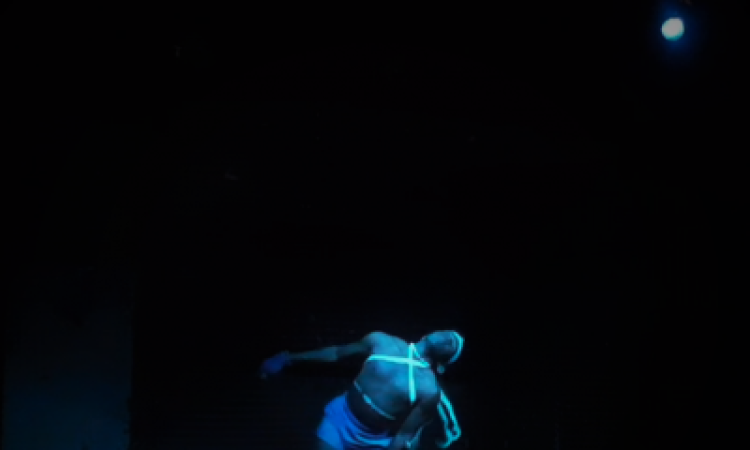Talk to me, babies.
Vitche-Boul Ra voices the command over the blackness of the Zoom. It does not take long before their performance becomes a conjuring of sorts. The question in my audience-mind expands from who is speaking to what is speaking. Ra self-identifies as a Transhumanist Folk-Theurgist and possesses an undeniable other-worldly magic as a performer. Still, I was surprised to feel their energy so clearly through a computer screen.
Talk to me, babies.
I am joined online by several others, all of our cameras and mics turned off as we listen to these initial sonic offerings. The showing is part of the Radical Black Art and Performance Series, curated by Philadelphia-based artist Arien Wilkerson and presented by Contemporary Art Galleries at UCONN. Again, Ra’s deep voice drifts in:
I have a dream of blackness, excuse me, I mean darkness…
The accent in their speech is almost Transylvanian as they cycle through chants, incantations. Recurring words: darkness, slimy, plushy, warm, dream. Blackness. Darkness. At times the performance jumps into the chat box, the language occasionally slipping into AAVE, alternate spellings evocative of olde English or Paganism, and other unnamed dialects. Perhaps a language of Vitche’s own.
o kruise the thumb into mid heir and feed me
before I get hungry.
Feed me before I get angry.
I watch the steadily updating chatbox. What does It want? Suddenly on screen appears an entity with crystalline nails, a figure draped in mylar, a bleach blonde ponytail long enough to grace the floor. Ra’s cold blue contacts echo like portals on their brown skin. “Do I look like a baby, bitch?” The switch is instant: the voice is here, now, and distinctly Black and femme. They drip yogurt onto their face with one hand, holding an open banana in the other. “Strawberry yogurt? Banana? Shhheeei… I came here to eat.” But who or what is hungry? And what does it look like to be fed?
Over the course of the hour we witness Ra channel several different beings. One shakes and rocks, singing, “Tell me something good…” over and over. He reminds me of a houseless person one might see walking around the subways of Philadelphia. One being screams in a shrill tone, their voice nearly breaking, “F….U…N….G…U…S!!!!” evoking a possessed creature. Yet another serves it to us, their hands swirling, wrists curling into voguing shapes. I begin to think of these characters as Philly ghosts, drifting in and out of my screen. I am reminded of Jumatatu Poe’s research on “the switching,” or the improvisational practice which allows us “the immediate re-design of ourselves into other creatures, or other ways of being our innate creatures.”[1] Just as we become acquainted with a new being, Ra switches them up on us.
At the post show talk-back, we reflect on portals, mirrors, and glass. Their ultimate fantasy is to perform in a glass box forever—you can see their eyes light up at the thought. In a way, through the medium of the screen, Ra did enclose themselves, and their conjurings, into a see-through box of sorts. Their practice of realm-shifting evokes a crystal with many facets, catching one specific beam of light in one moment and a totally different one in the next. Though Ra admits to not yet having or even desiring language to describe the work, I am hungry for the entryway their words will one day provide.
The Radical Black Art and Performance Series, curated by Arien Wilkerson, had events running throughout February for Black History Month.
And forever in reflexive fade., Radical Black Art and Performance Series, UCONN Contemporary Art Galleries, Vitche-Boul Ra, Zoom, February 11.
[1] Excerpt from class description for “The Switching” written by Jumatatu Poe.






